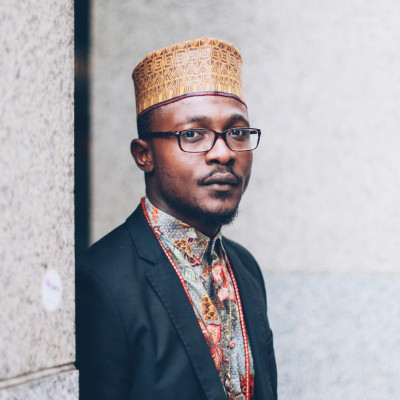Celebrating beauty and culture: Komi Olaf re-imagines the CBC Arts logo for Black History Month
The Ottawa-based artist shares the concept behind his design

Ottawa-based artist Komi Olaf designed the CBC Arts logo for February. (Courtesy of the artist)
Komi Olafimihan, or Komi Olaf as he’s usually known, is a painter and an award-winning spoken word poet. He also happens to be the designer behind the CBC Arts logo you’ll find on Facebook, Twitter and Instagram all February.
Raised in Nigeria and now based in Ottawa, Olaf’s artwork often takes an Afrofuturistic bent — and for our February profile pic, CBC Arts asked the artist to create a design that responds to Black History Month.
-
Q&A

Here, he tells the story behind his design, and shares a little about his current passions and points of inspiration.
Name: Komi Olafimihan
Age: 32
Homebase: Ottawa
Let’s talk about this design! What inspired your take on the CBC Arts logo?
When I was approached to design it, my first thoughts were, “It’s the CBC logo and it is so iconic, like the Nike symbol, and there’s really not much you can do to change that.”
But I wanted to attempt to at least scratch the surface of BHM and pay homage to beauty and culture.
Initially, I played around with the idea of adding different vignettes in the quadrants of the circles. However, I chose this one because of the bold bright colours and its attractiveness. It’s a celebration of Black history, which I have interpreted as Black people and culture.
I think that we need to keep celebrating Black history throughout the year.– Komi Olaf, artist
The blooming flowers speak to the concept of an idea coming into fruition. There are going to be a variety of different stories coming to the stage this year, through innovative artists and storytellers shedding light on issues from different more introspective perspectives.
I wanted to celebrate the Black woman in all her glory.
Who is the person in the design? What do they represent?
The person in the painting is a combination of three people. They are all fashion models from Africa: Ajak Deng, Alek Wek and Ajuma Nasenyana.
The concept of the image was the Nubian Empress. Nubia is recognized as the area between Central Sudan and Southern Egypt. In creating the image I tried to combine the facial features of all three people.
What is a Black person without black skin? Is it your skin that makes you Black? This image has features of a Black person but her skin is not black.
For you, what does it mean to celebrate Black History Month?
In Africa, we don’t celebrate Black History Month. But in the diaspora, we take a moment to remember, commemorate, celebrate the contributions of people of African descent that may not have been celebrated during other times of the year.
It’s like a little slice of the apple pie that we’ve been given, and it is sad, but that’s what we have.
I think it’s a beautiful celebration, but at the same time I think that even though during this month the whole of Canada turns to see what Black people are doing, I think that we need to keep celebrating Black history throughout the year.
How did you get into art and design?
I was always sort of interested in art growing up. When I came to Canada I studied architecture, and in architecture I got interested in design. We were designing buildings, but at the same time, in our courses we were encouraged and taught to design other things, like furniture, puppets and pavilions. I think that’s where design came into my life.
How do you like to describe your art?
My art practice is a manifestation of my explorations in life, my interests and my vision of a better world.
What art project are you most proud of?
I recently completed a mural inside Chubby’s Jamaican Kitchen, a new [Toronto] restaurant that opened in December last year.
It was the first time I was able to relinquish some sort of control in a project that I was involved in, working in a team environment to build and complete it.
What’s inspiring your artwork these days?
Last year I asked myself a question: what would Canada look like if it had never been colonized? I think my artwork these days is an attempt to answer that question.
Any artists inspiring your work?
Who’s the last artist you discovered online?
What’s your favourite place to see art?
At the artist’s studio or house if I have permission, primarily because then I get to see the art in context and potentially ask questions.
I like galleries that allow you to get really physically close to the work. Usually in museums, the bar is set a few feet away so you can’t get too close.
What’s one work of art you dream of owning?
Gala and the Tiger by Salvador Dali.
Source: CBC Arts

